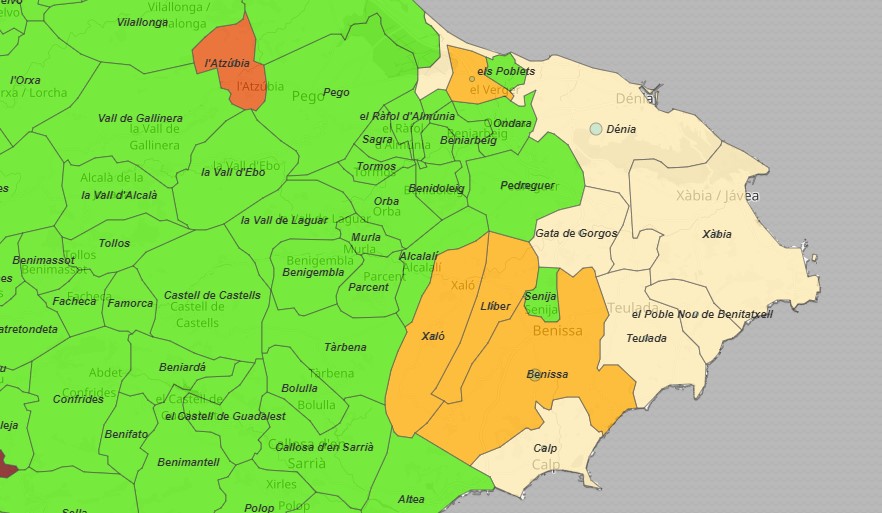VIRUS UPDATE: Xàbia’s infection rate rises again to the ‘Low Risk’ category
A curious readjustment of figures this week makes it difficult to identify the real picture of the situation in the Marina Alta.

Friday 21st May 2021 – Compiled by MIKE SMITH
Eight new positive cases have been detected in Xàbia in the last 14 days, according to the latest update from the regional health ministry in what seems to be another “readjustment” of the figures by the health authorities. Consequently, the number of positive cases recorded in the town since the beginning of the pandemic has jumped eight to 1,471.
The municipality’s 14-day IA rate, a measure of the speed at which the virus moves through the population, has risen sharply to 28.56 cases per 100,000 inhabitants, lifting the town back into the ‘Low Risk’ category. But this could still be a consequence of apparent adjustment of the data.
There have been no new deaths in Xàbia since late March and the number for remains at 12.
In the Marina Alta region, there have been 11 new positive cases detected in the past 14 days and the total number of positive cases since the pandemic began has risen to 10,084. However, the 14-day IA rate has risen only slightly to 36.74 cases per 100,000 inhabitants and the region remains in the ‘Low Risk’ category. There have been no new deaths since the last update and the region’s toll remains 203.
The continued readjustment of the data makes it difficult to identify the real picture at the moment. Some municipalities in the Marina Alta which have not recorded a positive case for some weeks have seen their totals increased or decreased in this update. For instance, Orba has had two cases removed from their total whilst neighbouring Vall de Laguar has seen their numbers rise by two; both municipalities haven’t recorded a positive PCR result in the last 14 days.
From the figures we do have, Adsubia is currently the only municipality in the Marina Alta in the ‘High Risk’ category with a 14-day IA rate of 163.67 whilst Xaló (139.47), Llíber (120.48), Benissa (97.45) and El Vergel (63.71) are at the ‘Medium Risk’ level. El Poble Nou de Benitatxell (44.92), Calp (38.58), Dénia (36.69), Gata de Gorgos (32.04), Xàbia (28.56) and Teulada (26.60) are in the ‘Low Risk’ category, whilst the rest are at the ‘New Normal’ level, with twenty municipalities – mostly in the inland valleys – showing no infection spread over the last 14 days.
Spain
Spain’s 14-day IA rate is 139.89 cases per 100,000 inhabitants and the country has dropped into the ‘Medium Risk’ category for the first time since March 26th. The rate has dropped almost 31% in the past two weeks, along with the Positivity Rate, the measure of how many coronavirus tests return positive, which has dropped to 5.10%, its lowest level since the end of March; a value of 5% or less would be indicative that transmission of the virus was under control; it’s getting closer.
Across the autonomous regions, the País Vasco still leads the way with a 14-day IA rate of 252.24 but it is now the only region in the highest ‘Extreme Risk’ category. The autonomous city Ceuta (11.88) remains the only region in the ‘New Normal’ category. The Comunidad Valenciana (29.66) remains at the ‘Low Risk’ level.
Infection spread has continued dropped in the majority of Spain’s autonomous regions and enclaves; Murcia continues to defy the trend, it’s 14-day IA rate having risen slowly over the last week to 66.57 but the region still remains in the ‘Low Risk’ category.
The newspaper El País has confirmed that Spain’s ‘fourth wave’ of infections has had a much smaller impact on public health that previous surges of the pandemic, partly thanks to the accelerating pace of the vaccination campaign
Vaccination (20.05.21)
Spain has administered 23,503,085 doses of vaccine, which is 91.9% of those which it has already received. A total of 7,697,288 people have completed the recommended course, which is 19.2% of the total of the population which is to be vaccinated (40,129,822).
According to the latest data provided by the health authorities, 93.1% of people aged 60 and over in Spain have received at least one dose, with 53.1% having completed the recommended course.
The Comunidad Valenciana has administered 2,359,667 doses of vaccine, which is 91.5% of the total which it has received. A total of 764,907 people have completed the recommended course, which 17.9% of the population which is to be vaccinated (4,289,305).
According to the latest data provided by the health authorities, 93.7% of people aged 60 and over in the Comunidad Valenciana have received at least one dose, with 49.7% having completed the recommended course.
LINKS
- Actualización nº 379. Enfermedad por el coronavirus (COVID-19). 20.05.2021
- GIV COVID-19 Gestión integral de la vacunación COVID-19
- COVID-19 C. Valenciana: Monitoratge de la situació




